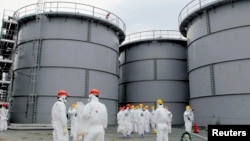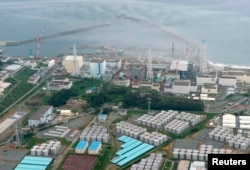More than two years after suffering a nuclear disaster, Japan is stuck in damage-control mode.
The embattled operator of the Fukushima Daiichi power plant, which suffered multiple meltdowns after it was hit by a massive earthquake and tsunami in March 2011, is scrambling amid new revelations that hundreds of tons of contaminated water have leaked from a steel storage tank and into the ground.
As it fights to contain the leak and address the possibility that hundreds of similar tanks could also leak and contribute to contamination reaching the nearby Pacific Ocean, numerous other challenges loom.
One is how to prevent the seepage of contaminated water into the groundwater. Another is the highly dangerous task of removing spent fuel rods from one of the plant's damaged reactor buildings. And then there is the issue of what to do with the radioactive water that has been stored.
The Tokyo Electric Power Company (TEPCO) is currently injecting water into damaged reactors to keep them cool and pumping out contaminated water.
But Komei Hosokawa, professor of environmental sociology at Kyoto Seika University in Japan, says that international assistance will be needed to deal with the mounting issues.
"TEPCO hasn't been working very [well] to handle the situation, and the Japanese government is sort of utterly lost," he says. "The government at the moment is very reluctant to issue an SOS, but I think we should. It's really an emergency going on."
'No Time To Waste'
Problems with contaminated water leaks reached a new crisis point this week. TEPCO's Masayuki Ono announced on August 20 that highly radioactive water had leaked from one of the hundreds of storage tanks.
"We have measured the total volume of the leakage from the tank, which we confirmed to be 300 square meters [of radioactive water]," Ono said.
News of the leak led Shunichi Tanaka, the head of Japan's nuclear watchdog, to tell a news conference on August 21 that there was "no time to waste" and "to assume that what has happened once could happen again, and to prepare for more."
The watchdog has proposed upping the description of the leak from "an anomaly" to a "serious incident."
Other tanks had similar leaks in the past, but TEPCO said the latest leak was the worst in terms of volume.
TEPCO admitted the toxic water may contaminate groundwater and flow into the Pacific Ocean "in the longer term."
But the firm said it was working to avoid such a situation, with workers transferring the contaminated water from a tank with a leakage problem to unbroken tanks, and retrieving leaked water and soil around it.
"It's really not under control. I mean, we have no other way but to put water into the reactors to cool them down," Hosokaway says. "But the water is a problem because the whole structure of the reactors and the buildings are all damaged, so there are so many leaks. And the water is contaminated with the nuclear fuel, so it contains very strong radioactivity."
Haven't Been 'Proactive'
The August 20 announcement follows the revelation last month that some 300 tons of radioactive groundwater has been seeping out of the plant a day into the Pacific Ocean.
TEPCO has started pumping the groundwater out of one location to reduce the leakage.
When the operation reaches its full capacity, it is expected to pump 100 tons a day from that area. The water is to be filtered and recycled to cool the reactors. However, it remains unclear when TEPCO will start pumping water from two other contaminated areas.
Hosokawa is very critical with TEPCO's handling of the water leaks.
"They are just running after what happens, and they haven't shown any proactive way to put the matter under control," he says.
TEPCO and the Japanese government are discussing proposals to build a wall of frozen ground around the reactor buildings that would create a barrier that isolates the compound from groundwater.
According to Hosokawa, this option is not viable over the long run.
"To maintain this frozen system is very, very expensive, very electricity consuming," he says. "It may work for a limited time -- say for several weeks -- to do some other things in the meantime. But you can't keep this system running for years."
No Other Choice
As TEPCO is scrambling to contain leaks, the firm is preparing to remove 400 tons of highly irradiated spent fuel from another part of the facility.
Extracting the more than 1,300 used fuel-rod assemblies from a badly damaged reactor building is unprecedented and fraught with danger.
Some experts say that includes the possibility of a release of radiation that could lead to a worse disaster than the March 2011 nuclear crisis at Fukushima, the world's most serious since Chornobyl in 1986.
But Hosokawa says there is no other choice than attempting the operation, which he thinks will not be conducted before next year.
"Because of the radiation that comes out from the spent fuel, everything must be done by remote operation," Hosokawa says. "Keeping all the spent fuel inside the pool would be much more dangerous. And that could end up in the massive release [of radiation] if a big earthquake comes again."
According to the World Nuclear Industry Status Report 2013, to which Hosokawa is a contributor, "Full release from the Unit-4 spent fuel pool, without any containment or control, could cause by far the most serious radiological disaster to date."
The embattled operator of the Fukushima Daiichi power plant, which suffered multiple meltdowns after it was hit by a massive earthquake and tsunami in March 2011, is scrambling amid new revelations that hundreds of tons of contaminated water have leaked from a steel storage tank and into the ground.
As it fights to contain the leak and address the possibility that hundreds of similar tanks could also leak and contribute to contamination reaching the nearby Pacific Ocean, numerous other challenges loom.
One is how to prevent the seepage of contaminated water into the groundwater. Another is the highly dangerous task of removing spent fuel rods from one of the plant's damaged reactor buildings. And then there is the issue of what to do with the radioactive water that has been stored.
The Tokyo Electric Power Company (TEPCO) is currently injecting water into damaged reactors to keep them cool and pumping out contaminated water.
But Komei Hosokawa, professor of environmental sociology at Kyoto Seika University in Japan, says that international assistance will be needed to deal with the mounting issues.
"TEPCO hasn't been working very [well] to handle the situation, and the Japanese government is sort of utterly lost," he says. "The government at the moment is very reluctant to issue an SOS, but I think we should. It's really an emergency going on."
'No Time To Waste'
Problems with contaminated water leaks reached a new crisis point this week. TEPCO's Masayuki Ono announced on August 20 that highly radioactive water had leaked from one of the hundreds of storage tanks.
"We have measured the total volume of the leakage from the tank, which we confirmed to be 300 square meters [of radioactive water]," Ono said.
News of the leak led Shunichi Tanaka, the head of Japan's nuclear watchdog, to tell a news conference on August 21 that there was "no time to waste" and "to assume that what has happened once could happen again, and to prepare for more."
The watchdog has proposed upping the description of the leak from "an anomaly" to a "serious incident."
Other tanks had similar leaks in the past, but TEPCO said the latest leak was the worst in terms of volume.
TEPCO admitted the toxic water may contaminate groundwater and flow into the Pacific Ocean "in the longer term."
But the firm said it was working to avoid such a situation, with workers transferring the contaminated water from a tank with a leakage problem to unbroken tanks, and retrieving leaked water and soil around it.
"It's really not under control. I mean, we have no other way but to put water into the reactors to cool them down," Hosokaway says. "But the water is a problem because the whole structure of the reactors and the buildings are all damaged, so there are so many leaks. And the water is contaminated with the nuclear fuel, so it contains very strong radioactivity."
Haven't Been 'Proactive'
The August 20 announcement follows the revelation last month that some 300 tons of radioactive groundwater has been seeping out of the plant a day into the Pacific Ocean.
TEPCO has started pumping the groundwater out of one location to reduce the leakage.
When the operation reaches its full capacity, it is expected to pump 100 tons a day from that area. The water is to be filtered and recycled to cool the reactors. However, it remains unclear when TEPCO will start pumping water from two other contaminated areas.
Hosokawa is very critical with TEPCO's handling of the water leaks.
"They are just running after what happens, and they haven't shown any proactive way to put the matter under control," he says.
TEPCO and the Japanese government are discussing proposals to build a wall of frozen ground around the reactor buildings that would create a barrier that isolates the compound from groundwater.
According to Hosokawa, this option is not viable over the long run.
"To maintain this frozen system is very, very expensive, very electricity consuming," he says. "It may work for a limited time -- say for several weeks -- to do some other things in the meantime. But you can't keep this system running for years."
No Other Choice
As TEPCO is scrambling to contain leaks, the firm is preparing to remove 400 tons of highly irradiated spent fuel from another part of the facility.
Extracting the more than 1,300 used fuel-rod assemblies from a badly damaged reactor building is unprecedented and fraught with danger.
Some experts say that includes the possibility of a release of radiation that could lead to a worse disaster than the March 2011 nuclear crisis at Fukushima, the world's most serious since Chornobyl in 1986.
But Hosokawa says there is no other choice than attempting the operation, which he thinks will not be conducted before next year.
"Because of the radiation that comes out from the spent fuel, everything must be done by remote operation," Hosokawa says. "Keeping all the spent fuel inside the pool would be much more dangerous. And that could end up in the massive release [of radiation] if a big earthquake comes again."
According to the World Nuclear Industry Status Report 2013, to which Hosokawa is a contributor, "Full release from the Unit-4 spent fuel pool, without any containment or control, could cause by far the most serious radiological disaster to date."

